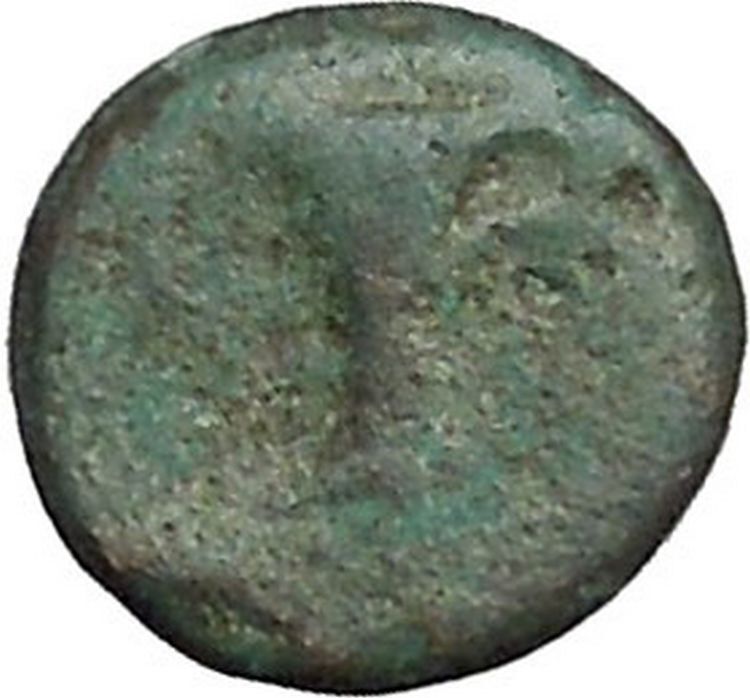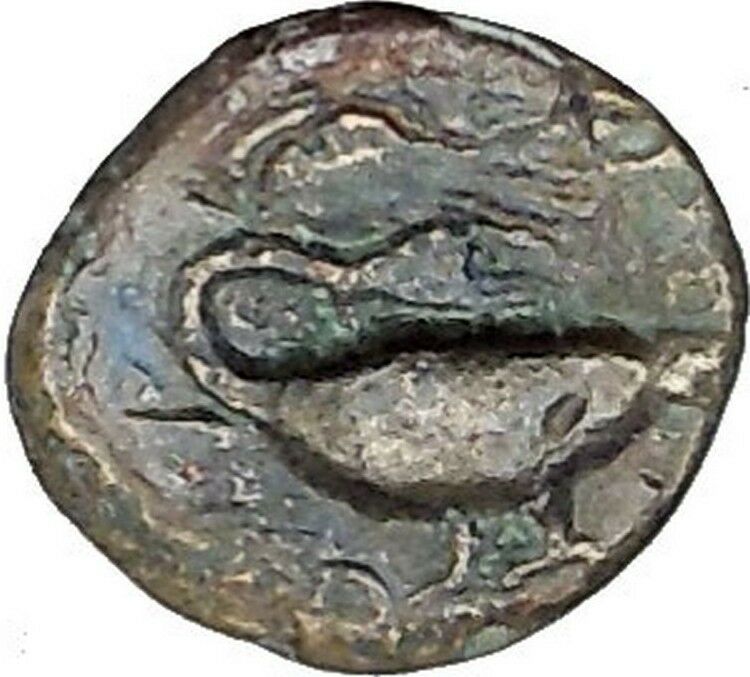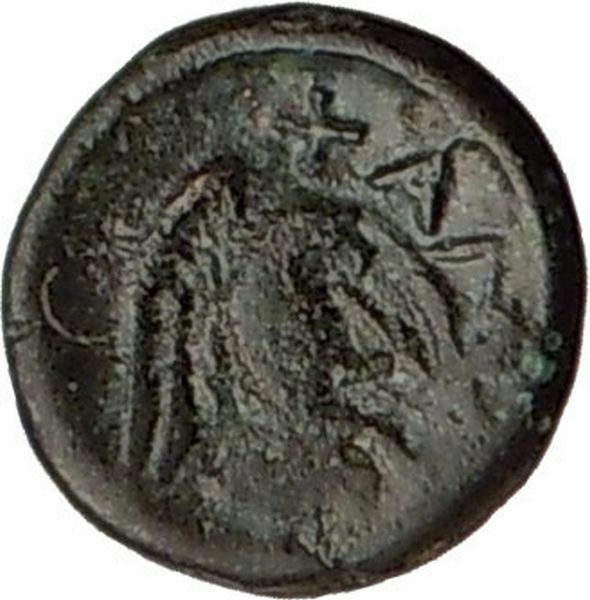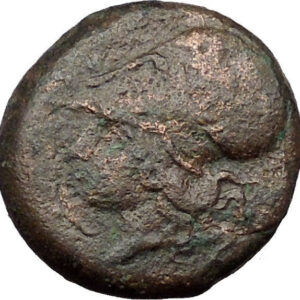|
Greek city of Amphipolis in Macedonia
Bronze 23mm (8.46 grams) Struck circa 196-168 B.C.
Head of Apollo right.
MAKE / ΔONΩΝ above and below lyre
with bow to left and monogram to right.
* Numismatic Note: Very rare, possibly unpublished coin.
Founded by Athenians in 436 B.C. to protect their mining
interests in the north, Amphipolis surrendered to the Spartan general Brasidas
in 424. The city preserved its independence until 357 when it was captured by
Philip II, King of Macedon.
You are bidding on the exact item pictured,
provided with a Certificate of Authenticity and Lifetime Guarantee of
Authenticity.
The lyre (Greek:
λύρα) is a
stringed musical instrument
known for its use
in Greek
classical antiquity
and later. The word comes
from the
Greek
“λύρα” (lyra)
and the earliest reference to the word is the
Mycenaean Greek
ru-ra-ta-e, meaning
“lyrists”, written in
Linear B
syllabic script.
The earliest picture of a lyre with seven strings appears in the famous
sarcophagus
of
Hagia Triada
(a
Minoan
settlement in
Crete
). The sarcophagus was used during the
Mycenaean
occupation of Crete (1400 BC).
The recitations of the
Ancient Greeks
were acco mpanied mpanied
by lyre playing. The lyre of classical antiquity was ordinarily played by being
strummed with a plectrum
, like a
guitar
or a
zither
, rather than being plucked, like a
harp. The fingers of the free hand silenced the unwanted strings in
the chord. The lyre is similar in appearance to a small harp but with distinct
differences.
The word lyre can either refer specifically to a common
folk-instrument, which is a smaller version of the professional
kithara
and eastern-Aegean
barbiton
, or lyre can refer generally to
all three instruments as a family.
The term is also used
metaphorically
to refer to the work or skill of
a poet
, as in
Shelley’s
“Make me thy lyre, even as the forest
is”
or Byron’s
“I wish to tune my quivering lyre,/To
deeds of fame, and notes of fire”

In
Greek
and
Roman mythology
, Apollo
,
is one of the most important and diverse of the
Olympian deities
. The ideal of the
kouros
(a
beardless youth), Apollo has been variously recognized as a god of light and the
sun; truth and prophecy;
archery
;
medicine and healing; music, poetry, and the arts; and more. Apollo is the son
of Zeus
and
Leto, and has a
twin
sister, the chaste huntress
Artemis
.
Apollo is known in Greek-influenced
Etruscan mythology
as Apulu. Apollo was worshiped in both
ancient Greek
and
Roman religion
, as well as in the modern
Greco
–Roman
Neopaganism
.
As the patron of Delphi
(Pythian Apollo), Apollo was an
oracular
god — the prophetic deity of the
Delphic Oracle
.
Medicine and healing were associated with Apollo, whether through the god
himself or mediated through his son
Asclepius
,
yet Apollo was also seen as a god who could bring ill-health and deadly
plague
as well as one who had the ability to cure. Amongst the god’s
custodial charges, Apollo became associated with dominion over
colonists
, and as the patron defender of herds and flocks. As the leader of
the Muses
(Apollon
Musagetes) and director of their choir, Apollo functioned as the patron god
of music and poetry
.
Hermes
created
the lyre
for him,
and the instrument became a common
attribute
of Apollo. Hymns sung to Apollo were called
paeans
.
In Hellenistic times, especially during the third century BCE, as Apollo
Helios he became identified among Greeks with
Helios
,
god of
the sun
, and his sister Artemis similarly equated with
Selene
,
goddess
of the moon
.
In Latin texts, on the other hand, Joseph Fontenrose declared himself unable to
find any conflation of Apollo with
Sol
among the
Augustan poets
of the first century, not even in the conjurations of
Aeneas
and
Latinus
in
Aeneid
XII
(161–215).
Apollo and Helios/Sol remained separate beings in literary and mythological
texts until the third century CE.
Amphipolis was an
ancient
Greek
city
in the
region once inhabited by the
Edoni
people in
the present-day
periphery
of
Central
Macedonia
. It was built on a raised plateau overlooking the east bank of the
river
Strymon
where it emerged from Lake Cercinitis, about 3 m. from the
Aegean Sea
.
Founded in 437 BC, the city was finally abandoned in the 8th century AD. The
present municipality Amfipoli, named after the ancient city, occupies the site.
Currently, it is a municipality in the
Serres
Prefecture
,
Central
Macedonia
with a population of 3,623 (2001 census).
Origins
Archaeology
has uncovered remains at
the site dating to approximately 3000 BC. Due to the strategic location of the
site it was fortified from very early.
Xerxes I
of Persia
passed during his invasion of Greece of 480 BC and buried alive
nine young men and nine maidens as a sacrifice to the river god. Near the later
site of Amphipolis
Alexander I
of Macedon
defeated the remains of Xerxes’ army in 479 BC.
Throughout the 5th century BC,
Athens
sought to consolidate its control over Thrace, which was
strategically important because of its primary materials (the gold and silver of
the
Pangaion hills
and the dense forests essential for naval construction), and
the sea routes vital for Athens’ supply of grain from
Scythia
.
After a first unsuccessful attempt at colonisation in 497 BC by the
Miletian
Tyrant
Histiaeus
,
the Athenians founded a first colony at Ennea-Hodoi (‘Nine Ways’) in 465, but
these first ten thousand colonists were massacred by the
Thracians
.
A second attempt took place in 437 BC on the same site under the guidance of
Hagnon
, son of
Nicias
.
The new settlement took the name of Amphipolis (literally,
“around the city”), a name which is the subject of much debates about
lexicography
.
Thucydides
claims the name comes from the fact that the Strymon flows “around the city” on
two sides;
however a note in the Suda
(also given in the lexicon of
Photius
) offers a different explanation apparently given by
Marsyas
, son
of Periander
:
that a large proportion of the population lived “around the city”. However, a
more probable explanation is the one given by
Julius Pollux
: that the name indicates the vicinity of an
isthmus
.
Furthermore, the
Etymologicum Genuinum
gives the following definition: a city of the
Athenians or of Thrace, which was once called Nine Routes, (so named) because it
is encircled and surrounded by the Strymon river. This description corresponds
to the actual site of the city (see adjacent map), and to the description of
Thucydides.
Amphipolis subsequently became the main power base of the
Athenians in Thrace and, consequently, a target of choice for their
Spartans
adversaries. The Athenian population remained very much in the minority within
the city.
An Athenian rescue expedition led by strategist (and later historian) Thucydides
had to settle for securing
Eion and could not
retake Amphipolis, a failure for which Thucydides was sentenced to exile. A new
Athenian force under the command of
Cleon
failed once
more in 422 BC during a
battle
at which both Cleon
and Brasidas
lost their lives. Brasidas survived long enough to hear of the defeat of the
Athenians and was buried at Amphipolis with impressive pomp. From then on he was
regarded as the founder of the city
and honoured with yearly games and sacrifices. The city itself kept its
independence until the reign of the king
Philip
II
despite several other Athenian attacks, notably because of the government
of
Callistratus
of Aphidnae
.
Conquest
by the Romans
In 357 BC, Philip removed the block which Amphipolis presented
on the road to Macedonian control over Thrace by conquering the town, which
Athens had tried in vain to recover during the previous years. According the
historian Theopompus
, this conquest came to be the object of a secret accord between
Athens
and
Philip II, who would return the city in exchange for the fortified town of
Pydna
, but the
Macedonian king betrayed the accord, refusing to cede Amphipolis and laying
siege to Pydna.
After the conquest by Philip II, the city was not immediately
incorporated into the kingdom, and for some time preserved its institutions and
a certain degree of autonomy. The border of Macedonia was not moved further
east; however, Philip sent a number of Macedonians governors to Amphipolis, and
in many respects the city was effectively ‘Macedonianized’. Nomenclature, the
calendar and the currency (the
gold stater
,
installed by Philip to capitalise on the gold reserves of the Pangaion hills,
replaced the Amphipolitan
drachma
) were all replaced by Macedonian equivalents. In the reign of
Alexander
,
Amphipolis was an important naval base, and the birthplace of three of the most
famous Macedonian
Admirals
: Nearchus
, Androsthenes[6]
and
Laomedon
whose burial place is most likely marked by the famous lion of
Amphipolis.
Amphipolis became one of the main stops on the Macedonian
royal road (as testified by a border stone found between
Philippos
and Amphipolis giving the distance to the latter), and later on
the ‘Via
Egnatia’, the principal
Roman Road
which crossed the southern Balkans. Apart from the ramparts of
the low town (see photograph), the gymnasium and a set well-preserved frescoes
from a wealthy villa are the only artifacts from this period that remain
visible. Though little is known of the layout of the town, modern knowledge of
its institutions is in considerably better shape thanks to a rich epigraphic
documentation, including a military ordinance of
Philip V
and an
ephebarchic
law from the gymnasium. After the final victory of
Rome
over Macedonia in a
battle
in 168 BC,
Amphipolis became the capital one of the four mini-republics, or ‘merides’,
which were created by the Romans out of the kingdom of the
Antigonids
which
succeeded
Alexander’s Empire in Macedon. These ‘merides’ were gradually
incorporated into the Roman client state, and later province, of
Thracia
.
Revival
in Late Antiquity
During the period of
Late Antiquity
,
Amphipolis benefited from the increasing economic prosperity of Macedonia, as is
evidenced by the large number of
Christian Churches
that were built. Significantly however, these churches
were built within a restricted area of the town, sheltered by the walls of the
acropolis
.
This has been taken as evidence that the large fortified perimeter of the
ancient town was no longer defendable, and that the population of the city had
considerably diminished.
Nevertheless, the number, size and quality of the churches
constructed between the fifth and sixth centuries are impressive. Four
basilicas
adorned with rich mosaic
floors and elaborate architectural sculptures (such as the ram-headed
column
capitals
– see picture) have been excavated, as well as a church with a hexagonal central
plan which evokes that of the
basilica
of
St. Vitalis
in
Ravenna
. It
is difficult to find reasons for such municipal extravagance in such a small
town. One possible explanation provided by the historian
André Boulanger
is that an increasing ‘willingness’ on the part of the
wealthy upper classes in the late Roman period to spend money on local
gentrification
projects (which he terms ‘’évergétisme’’,
from the Greek verb εύεργετέω,(meaning ‘I do good’) was exploited by the local
church to its advantage, which led to a mass gentrification of the urban centre
and of the agricultural riches of the city’s territory. Amphipolis was also a
diocese
under
the
suffragan
of
Thessaloniki
– the Bishop of Amphipolis is first mentioned in 533 AD.
From
the reduction of the urban area to the disappearance of the city
The
Slavic invasions
of the late 6th century gradually encroached on the
back-country Amphipolitan lifestyle and led to the decline of the town, during
which period its inhabitants retreated to the area around the acropolis. The
ramparts were maintained to a certain extent, thanks to materials plundered from
the monuments of the lower city, and the large unused cisterns of the upper city
were occupied by small houses and the workshops of artisans. Around the middle
of the 7th century AD, a further reduction of the inhabited area of the city was
followed by an increase in the fortification of the town, with the construction
of a new rampart with pentagonal towers cutting through the middle of the
remaining monuments. The acropolis, the
Roman baths
,
and especially the Episcopal basilica were crossed by this wall.
The city was probably abandoned in the eighth century, as the
last bishop was attested in 787. Its inhabitants probably moved to the
neighbouring site of ancient
Eion, port of
Amphipolis, which had been rebuilt and refortified in the
Byzantine period
under the name “Chrysopolis”.
This small port continued to enjoy some prosperity, before being abandoned
during the
Ottoman period
.
The last recorded sign of activity in the region of Amphipolis was the
construction of a fortified tower to the north in 1367 by
Grand Primicier
Jean and the
Stratopedarque
Alexis to protect the land that they had given to the
monastery of Pantokrator on
Mount
Athos
.
Archaeology
The site was rediscovered and described by many travellers and
archaeologists during the 19th century, including E. Cousinéry (1831)
(engraver), L. Heuzey (1861), and P. Perdrizet (1894–1899). In 1934, M. Feyel,
of the
École française d’Athènes
, led an
epigraphical
mission
to the site and uncovered the remains of a funeral lion (a
reconstruction was given in the,
a publication of the EfA which is available on line). However, excavations did
not truly begin until after the Second World War. The
Greek Archaeological Society
under D. Lazaridis excavated in 1972 and 1985,
uncovering a necropolis, the rampart of the old town (see photograph), the
basilicas, and the acropolis.
Amphipolitans
-
Demetrius of Amphipolis
, student of
Plato’s
- Zoilus
(400 BC-320 BC), grammarian,
cynic philosopher
-
Pamphilus (painter)
, head of
Sicyonian
school and teacher of
Apelles
- Aetion
, sculptor
-
Philippus of Amphipolis
, historian
- Nearchus
, admiral
- Erigyius
, general
- Damasias
[disambiguation
needed] of Amphipolis 320 BC
Stadion
Olympics
-
Hermagoras of Amphipolis
(c. 225
BC), stoic philosopher ,follower of
Persaeus
- Xena
, the Warrior Princess of Amphipolis.
|





 mpanied
mpanied



